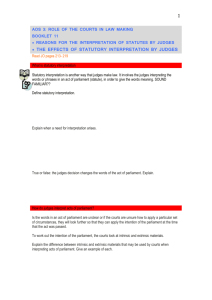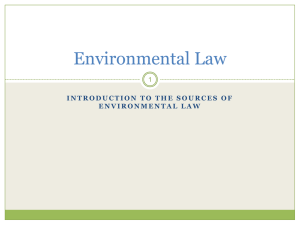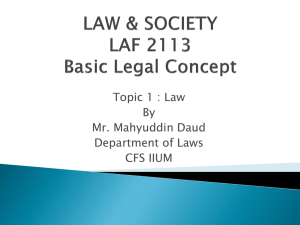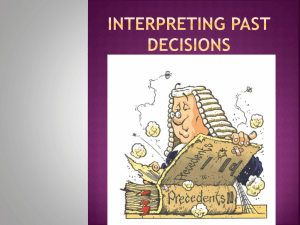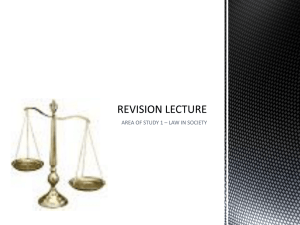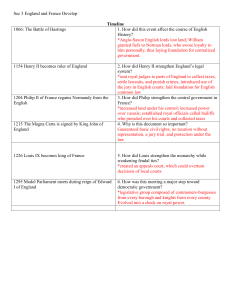a short introduction to the english legal system
advertisement
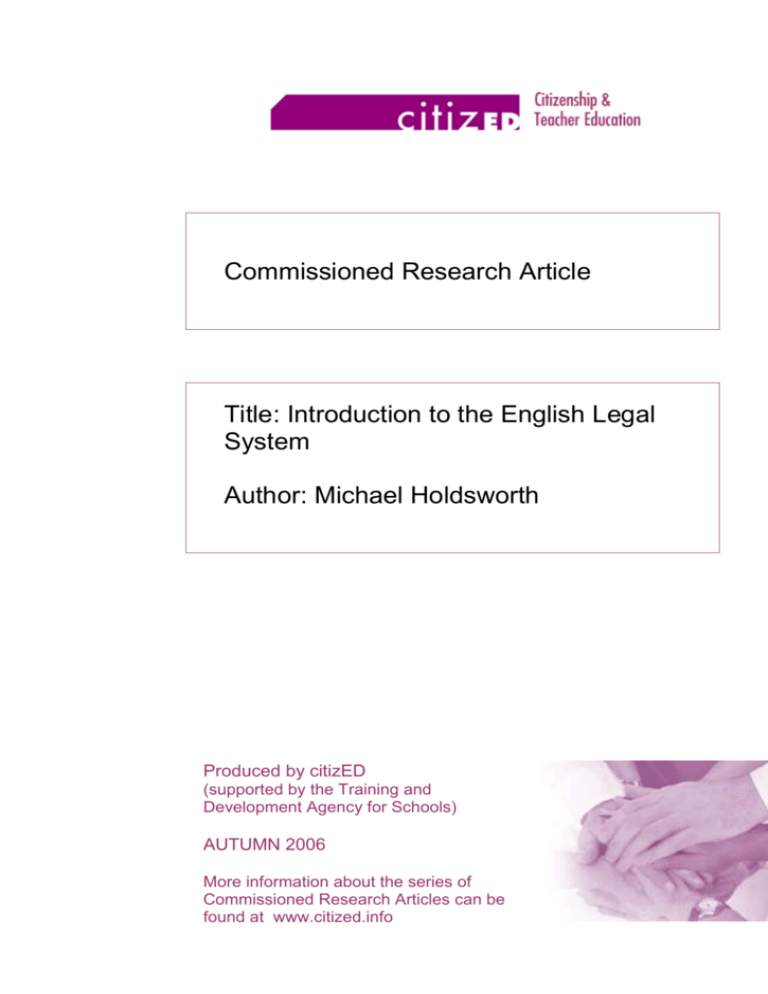
Commissioned Research Article Title: Introduction to the English Legal System Author: Michael Holdsworth Produced by citizED (supported by the Training and Development Agency for Schools) AUTUMN 2006 More information about the series of Commissioned Research Articles can be found at www.citized.info A SHORT INTRODUCTION TO THE ENGLISH LEGAL SYSTEM The DfES key stage 4 guidelines for the teaching of Citizenship as part of the National Curriculum state that in acquiring knowledge and understanding about becoming informed citizens, students should be taught about: ‘the legal and human rights and responsibilities underpinning society and how they relate to citizens, including the role and operation of the criminal and civil justice systems.’1 One of the key skills that students should develop is the ability to ‘study, think about and discuss topical political, spiritual, moral, social and cultural issues, problems and events.’2 The guidelines recognise that this can only be achieved through a growing awareness of the legal, political, religious, social, constitutional and economic systems that influence lives and communities. This article focuses on one of those systems, the English legal system. However, recognising that this system of justice cannot be fully understood in isolation, we begin with a brief comment on the UK’s constitutional arrangements to show how the English legal system is the necessary product of the concept that is commonly referred to as ‘the rule of law’. Introduction The classical understanding of Britain’s unwritten constitutional tradition is that it rests on three pillars, namely: parliamentary sovereignty; the separation of powers; and the rule of law. To place the English legal system in its proper context, it is necessary to have some understanding of these concepts and particularly the rule of law. Briefly, parliamentary sovereignty refers to the legislative supremacy of the UK Parliament. It means that there is no limit (apart from any self-imposed limit) on the capacity of the House of Commons, the House of Lords and the Crown to enact laws in the UK. The UK Parliament is the principal source of UK law. The separation of powers refers to the idea that there is some degree of independence in the exercise of the different functions of government. Conventionally, these functions are described as the legislative, executive and judicial functions of government and can be seen most clearly in the work of Members of Parliament and the House of Lords (the legislature), the Cabinet 1 2 www.nc.uk.net > Citizenship > key stage 4 Ibid. 2 (the executive) and the Judges (the judiciary). This separation is understood as being beneficial to the healthy operation of democratic government as, in theory at least, it provides a system of checks and balances that prevent too much state power being concentrated in the hands of one group. The new Supreme Court3, once in operation, will practically and visibly strengthen the constitutional separation between the legislature and the judiciary, primarily by taking judges out of the House of Lords. Current debate on the separation of powers focuses on whether, in practice, too much power resides in the hands of the executive. The rule of law is something of an allusive notion that is difficult to pin down. There are several classic formulations of what the rule of law is but perhaps a glimpse of its essential nature can be seen by imagining each person in society asking themselves the question: Why should I obey the law? This is one of those strange questions that we may ask ourselves from time to time when we suddenly choose to question something that ‘seems’ both an obvious and a given part of the social order. We grow up with a notion of the law and often, its presence can seem as pervasive and constant as the air we breathe. At the same time, we take the existence of the law, the making of the law, the interpretation of the law and the application of the law for granted. The International Bar Association’s ‘Rule of Law Resolution’ (2005) states that: ‘The Rule of Law is the foundation of civilised society. It establishes a transparent process accessible and equal to all. It ensures adherence to principles that both liberate and protect.’ The truth, of course, is that everyone does not always obey the law, nor is there always a consensus on what the law is or should be. However, the maintenance of life in a modern democracy requires a willingness from most citizens for most of the time to observe the laws, even when individually they may not agree with them. The rule of law, therefore, concerns the nature of the legal relationships between individuals and between the individuals and the state. It also concerns the range of processes through which the law governing those relationships can be enforced and administered. Principal themes that have grown out of the concept of the rule of law as it has developed in the UK are, for example: 3 that the law should not be arbitrarily or capriciously administered by those in power; that all people are equal before the law; Created by the Constitutional Reform Act 2005 and expected to begin operating in 2009. 3 that there should be a system to apply and interpret the law fairly and for all citizens. The rest of this article is precisely about this system - the English legal system4. If asking the question, “why should I obey the law?”, questions something we usually take for granted, then we are fortunate to have had that luxury in the past. Many countries do not have the benefit of the rule of law or a system of justice that is regularly applied without fear, favour or prejudice. In more recent times and especially since the recent growth of global terrorism, we must become increasingly aware that we can no longer take the benefits of a regular legal system for granted. For further information see: http://www.roldirectory.org/index.htm - the International Bar Association’s Rule of Law Directory. THE ENGLISH LEGAL SYSTEM The sources of UK law There are a number of law making institutions: Institutions within the European Union (EU); The UK Parliament and government; The courts; Regulatory bodies; and International institutions European Union Law The EU was founded in 1957 and currently has 25 Member States with two more countries, Bulgaria and Romania, joining on 1 January 2007. The UK joined in 1973 and since then, the UK Parliament has bound itself to incorporate EU law into national law. While the UK remains a member of the EU, EU law takes precedence over national law. This means that the UK Parliament is no longer the supreme law-maker and, for the time being at least, it has limited its sovereignty. The institutions of the EU The Council of Ministers 4 This article does not deal with the content, application or enforcement of Human Rights law. 4 The Council is the main decision-making body of the EU and consists of one minister from each Member State who is authorised to commit that State to legislative proposals. The European Commission The Commission is made up of 25 Commissioners, one from each Member State, appointed for a five-year term of office. The Commission directs EU policy and brings legislative proposals before the Council for consideration. The European Parliament The Parliament consists of elected citizens from each of the Member States and there are currently 78 MEPs from the UK. Interestingly, and unlike the UK Parliament, the European Parliament has no direct law making powers. It debates legislative proposals and is permitted to put questions to the Commission and the Council. The European Court of Justice (ECJ) The ECJ is based in Luxembourg. It has 25 judges, one from each Member State and 8 Advocates-General. The Advocates-General prepare an impartial and independent legal view of each case which is presented to the ECJ for consideration. The primary function of the European Court of Justice is to ensure that the interpretation and application of the Treaty of Rome 1957 (the EU’s founding Treaty) is observed. The ECJ has a wide jurisdiction over EU law and can hear cases brought by any of the EU institutions, Member States or individuals e.g. appeals from the House of Lords. For further information about the institutions of the EU see: http://news.bbc.co.uk/1/shared/spl/hi/europe/04/eu_institutions/html/introducti on.stm http://www.curia.europa.eu/en/instit/presentationfr/index_cje.htm - European Court of Justice The types of EU law EU law can have what is known as direct effect. That means that the law automatically becomes part of each Member State’s domestic law. Furthermore, EU law can have what is known as either vertical or horizontal direct effect. Vertical direct effect allows an individual to use a legal provision to legally challenge the act of the state, government or public body. Horizontal direct effect enables an individual or other body to legally challenge private individuals or bodies. The types of EU law are: Treaties: Vertical and in certain circumstances horizontal direct effect 5 Treaties are the primary sources of EU law and do not need to be given legal effect by the UK Parliament. Treaties can create individual rights. Regulations: Vertical and in certain circumstances horizontal direct effect Article 249 of the Treaty of Rome makes the effect of Regulations legally binding in every respect in each Member State without that Member State having also to implement the law. Citizens may rely on them both against the state and against private individuals or bodies. Directives: Vertical direct effect but not horizontal direct effect Directives are binding on Member States who are then left to implement their provisions into domestic law. In the UK, this is done either by Act of Parliament or secondary legislation (see below) and there is usually some scope for flexibility in the precise nature of the implementation. Once the provisions become part of domestic law, they can also have horizontal effect. Decisions: Decisions are rulings on a range of different issues. They can be addressed to Member States, individuals or other bodies and are binding on them. Recommendations and Opinions: no direct effect Recommendations and Opinions do not create enforceable rights but can be influential on the application of EU law in a Member State or its interpretation by the courts of that Member State. Recommendations and Opinions are not binding. EU case law: Decisions of the ECJ set a precedent to be followed by lower courts in a similar way to the common law tradition in England where judges make and develop the law through following previous decisions. While the ECJ can bind the House of Lords in the UK, the ECJ itself is not bound by its own decisions. The UK Parliament and government Parliamentary Sovereignty Before joining the EU, Parliamentary Sovereignty meant that the law made by the UK Parliament could not be challenged. When the UK joined the EU (then known as the European Economic Community or ECC) in 1973 it did so by passing the European Communities Act 1972. This effectively ended Parliamentary Sovereignty so that EU law now takes precedence over national law. In the case of R v Secretary of State for Transport, ex parte 6 Factortame (1990) this was put to the test and a conflict between a UK statute and Treaty of Rome was decided in favour of the Treaty of Rome. In recent years, law making powers have been devolved from the UK Parliament to other regional democratically elected bodies e.g. the National Assembly for Wales. Primary legislation In Britain, primary legislation is statutory and takes the form of an Act of Parliament. Usually, about 80 or so Acts of Parliament receive Royal Assent each year. Before it becomes law, an Act is called a Bill and passes through the parliamentary process in draft form being subject to debate, amendments and scrutiny by both Houses of Parliament. Once the Bill has been given the assent of the Monarch it becomes an Act of Parliament. However, an Act may not become legally ‘effective’ on the day of its assent, as the government may provide for another day(s) to be appointed on which the laws in the Act will come into force. An Act of Parliament can usually only be amended by passing another Act of Parliament containing those amendments. The House of Lords used to be able to prevent Bills from becoming law even where the House of Commons voted in favour of them. It is now accepted that this power is limited by the Parliament Acts of 1911 and 1949. It is possible for the House of Lords to delay a Bill (apart from a so called ‘money bill’ i.e. bills connected with the budget) for up to one year after which the government can re-introduce the Bill and if it passes in the House of Commons for a second time, it then becomes law. The prevailing will of the House of Commons is due to MPs being the democratically elected representatives of the citizens. Despite this, the power is used very rarely and most recently in the controversial passing of the Hunting Act 2004. Secondary legislation Many people do not realise the huge amount of secondary legislation made under the authority of an Act of Parliament. The Act gives authority to a person e.g. a Secretary of State or other body to make the detail of the law on Parliament’s behalf. For this reason, secondary legislation is also known as delegated legislation. It takes a number of forms but the most used type of delegated legislation takes the form of regulations or orders known as Statutory Instruments and typically some 3,000 are made each year. Secondary legislation is necessary simply because there is not time for Parliament to deal with all the detail of information, nor would they necessarily have the required specialist knowledge. There are parliamentary controls on secondary legislation although these are sometimes criticised for being insufficient. Delegated legislation has also been criticised for being undemocratic because it can be made by unelected individuals, often without a formal consultation process and with very little publicity. For further information see: 7 www.parliament.uk www.parliament.uk/bills/bills.cfm www.opsi.gov.uk/acts.htm 8 The English courts The courts are arranged in a hierarchical structure, an outline of which is illustrated in the following diagram5: 5 Judicial Statistics, Annual Report 2005 (CM6799) (London, The Stationery Office, 2006) 9 It can be seen that the House of Lords6 is the highest court in the UK and its decisions can only be overturned by a decision of the ECJ or the European Court of Human Rights. (These latter two institutions can also overturn the decisions of the lower courts.) The House of Lords should not be confused with the second legislative chamber of Parliament. The House of Lords when sitting as the most senior appellate court, consists of a number of Law Lords who hear appeals which have been sent to them by the Court of Appeal and which they have, in addition, agreed to hear. The direction of the arrows in the diagram, show broadly the path of appeals upwards from the decisions of the lower courts. After the House of Lords, the Court of Appeal’s decisions are the most authoritative and after those, the decisions of the High Court. The system whereby judges follow the decisions of higher courts is known as the ‘doctrine of precedent’ and it is this practice that has led to the development of the ‘common law’. England is a common law country and much of the minutiae of the law and indeed some of the law’s most basic principles are judge made, having been decided in cases heard in the courts. The common law can, of course, be changed by statute. Judicial Precedent Briefly, judicial precedent means that a decided rule of law is followed in similar cases until it is overturned or modified by a higher court. Where there is no previous decision on a point of law then a court may make its own decision, which may then be appealed in the higher courts. Once a higher court reaches a decision, that decision is binding on all lower courts in like-for-like cases. Courts must follow their own decisions, except the House of Lords and the High Court. The High Court must follow the decisions of its Divisional Courts and usually the later of two conflicting judgments. In 1966 the Lord Chancellor published a Practice Statement allowing the House of Lords, in exceptional circumstances, the flexibility to change its view despite there being a clear precedent to follow. This removes the possibility of the law becoming too rigid and the risk that the doctrine of precedent could restrict the healthy development of the law. Precedent can be either binding or persuasive. A past decision is binding if: The legal point being argued in court is the same as the legal point that was argued in the precedent 6 It is proposed that the new Supreme Court will take over the appellate function of the House of Lords and certain powers of the Judicial Committee of the Privy Council. 10 The facts of the case are of a similar nature to those of the precedent The precedent is a decision of a higher court A persuasive precedent can come from statements within relevant judgments from other courts which are higher or lower in the hierarchy, although the more senior courts will be more persuasive. Dissenting judgments can also be persuasive, as can the decisions of courts outside the English legal system e.g. the European Court of Human Rights and the courts of Commonwealth countries. Statutory interpretation Judges also play a role in interpreting Acts of Parliament and secondary legislation. This is often necessary because words can sometimes have more than one meaning and so interpretation can be confusing or ambiguous. The traditional approach to statutory interpretation has been a literal approach where the words are given their plain, dictionary meaning. This stands in contrast to the approach that tends to be favoured in Europe, where judges look to interpret the purpose of the law makers. This is known as taking a purposive approach. The literal approach tends to produce a very gradual, conservative and restrictive attitude towards legal development; the idea being that judges should not make law but simply implement what Parliament has decided. It is now commonly accepted that judges do in fact make law and the purposive approach allows judges to interpret what they think Parliament was trying to achieve. It would be fair to say that there has been a steady move towards a more purposive approach in the English courts. However, the literal approach is still dominant and this is reflected in the various technical rules of statutory interpretation to ascertain the meaning of a statute and the rules to aid the interpretation of individual words. Systems of justice upheld and enforced by the courts The English legal system has a number of distinct systems of justice which operate internally according to their own, often complex, procedures. One of the most fundamental distinctions is between the criminal justice system and the civil justice system.7 Indeed, the civil justice system could itself be subdivided into, for example, the administrative justice system8 and the family justice system. For further information see: www.hmc-service.gov.uk – Her Majesty’s Court Service 7 See the brief explanation of each system below. Administrative law is a special sort of civil law that mainly concerns the interactions of citizens with the state, especially where the state is making decisions affecting individual citizens. Administrative law cases are mostly heard in tribunals specific to the subject. 8 11 www.dca.gov.uk – the Department for Constitutional Affairs website contains links to the principal systems of justice enforced by the courts. Regulatory bodies There are a number of national regulatory bodies which have the power to make rules and regulations which are binding on citizens in certain circumstances. Usually, this rule making power is conferred by Act of Parliament so the regulatory body becomes an agent of the government. Such bodies include, for example: The Financial Services Authority (FSA) – regulates the UK’s financial markets and other financial activities in an attempt to ensure fairness and transparency for investors and those who buy financial products. The Law Society – regulates the provision of legal services by the solicitors’ profession, especially professional conduct. The Civil Aviation Authority (CAA) – regulates e.g. airports, air traffic services and safety. The practice of devolving power from central government to separate regulatory bodies is increasing. International law making bodies There are a number of international institutions whose policies and rules can become part of national laws e.g. shipping law, conventions of warfare, use of the internet. Development in communications, transport and the increasing awareness of issues which affect everyone on the planet e.g. climate change, global terrorism and genetic research will inevitably result in calls for law to be made increasingly on an international rather than national basis. The English Legal System in Practice The provision of legal services It is a common misunderstanding that all legal work is carried out by lawyers through the courts. This is wrong in two respects: Firstly, while there is a distinct legal profession consisting principally of solicitors and barristers, many other people are involved in the English legal system e.g. the police, magistrates, juries etc. Secondly, many lawyers (particularly solicitors) rarely become involved with the work of the courts. This is especially the case where a solicitor specialises in what is known as ‘non-contentious’ work. Non-contentious work involves acting for clients in areas where they have no dispute with another party; clients simply want to organise their affairs legally and in such a way as 12 to reduce the risk of exposing themselves to any potential dispute in the future. Typical examples of non-contentious work include housing law, business and commercial law, wills and probate work. Even barristers, who predominantly concentrate on advocacy work (representing clients in court), carry out other work, for example, advising on a particular area of law in which they have expertise. Indeed, some barristers working in areas such a taxation or patent law may rarely ever appear in court. The Judiciary The Lord Chancellor is responsible for the Judiciary and also the government Department for Constitutional Affairs. The appointment of Lord Chancellor is a political appointment made by the Prime Minister. Traditionally, the role of Lord Chancellor has been criticised on constitutional grounds for undermining the concept of ‘the separation of powers’. This is because, until recently, his office involved being speaker in the House of Lords, taking a seat in Cabinet and being a judge and the head of the Judiciary. However, as a result of the Constitutional Reform Act 2005, the House of Lords agreed to elect its own presiding officer. The election took place on 28 June 2006 and it was announced on 4 July 2006 that the first elected Lord Speaker was to be Baroness Hayman. In addition, the Lord Chancellor is no longer a judge nor head of the Judiciary. Historically, the Lord Chancellor was responsible for judicial appointments. However, as a result of the Constitutional Reform Act 2005, the Judicial Appointments Commission (JAC) has been established. The JAC was launched in April 2006 and its role is to assess, select and recommend candidates for judicial appointment. The Lord Chancellor’s powers of judicial appointment have as a result been reduced and this is seen as strengthening the independence of judges. There are different kinds of judges and the most common distinction is made between what are known as superior judges and inferior judges: Superior judges Law Lords (their formal title is ‘Lords of Appeal in Ordinary’) sit in the House of Lords.9 Lords Justices of Appeal sit in the Court of Appeal. High Court Judges (also known as Puisne Judges) sit in the High Court and are appointed to one of the three ‘divisions’ of the High Court i.e. Queen’s Bench, Chancery or Family (see the diagram on page 8, above). Inferior Judges 9 see footnote 6, above 13 Circuit Judges are full-time judges who sit in the county court or Crown Court. Recorders are part-time judges that sit usually in the county court and Crown Court. District Judges sit in the county court and Magistrates’ Court. It is important that judges are independent and are seen to be independent. Judges cannot be sued for anything they do in connection with the exercise of their office and senior judges have security of tenure which means that they cannot be removed from office other than by the Monarch following a petition from both Houses of Parliament. Judges have in the past been criticised for being too conservative (both politically and socially) and personally unrepresentative of the diversity that exists within the UK’s population. The reforms brought about by the Constitutional Reform Act 2005 are, in part, designed to remedy this. For further information see: www.legalservices.gov.uk – the Legal Services Commission www.lawsociety.org.uk – solicitors’ regulator www.barcouncil.org.uk – barristers’ regulator www.dca.gov.uk – the website for the Department for Constitutional Affairs – links to judicial appointments procedures and statistics www.jsboard.co.uk – the Judicial Studies Board http://www.judicialappointments.gov.uk/ - The Judicial Appointments Commission A brief comparison between the criminal and civil justice systems One of the principal functions of the English Courts is to operate different systems of justice which are distinct according to the area of law they deal with and the court procedures employed. A fundamental distinction can be drawn between the criminal and civil justice systems. Broadly speaking, the criminal justice system enforces the criminal law in the criminal courts using its own criminal procedures. The civil justice system enforces the civil law in the civil courts using its own internal civil procedure rules. The main differences between the two systems are set out below: 14 The criminal justice system – the basics: The criminal law is a form of public law designed to prevent or enforce certain types of behaviour and punish offenders. Criminal cases are heard first in the Magistrates Court or the Crown Court. A prosecution is brought by the Crown Prosecution Service (CPS) usually following police investigation and arrest. The defendant will be tried by Magistrates in the Magistrates Court for non-serious crimes or by judge and jury in the Crown Court for serious crimes. In criminal cases, the burden of proof is known as ‘beyond reasonable doubt’ which means that the jury must have no reasonable doubt in the their mind that the defendant is guilty of the crime he is being tried for. If found guilty, the defendant can be fined and/or imprisoned or made subject to a community order. The civil justice system – the basics: The civil law is a form of private law because it governs the relationships between individuals in society e.g. contract law, planning law, company law. Civil cases are heard principally in the High Court and the county courts where allocation usually depends upon the size and complexity of a particular case. The usual scenario is that a claimant will sue a defendant hoping that the court will decide liability in his favour. The court has to make a decision on the basis of what is known as the ‘balance of probability’ where an assessment is made between what is the most likely version of the facts of a case. Once liability has been decided, the victor may be entitled to damages, usually in the form of a financial sum, or a decision of the court in the form of an injunction or declaration, which may for example, permit or prohibit a particular course of action. The division between civil and criminal law is seen most clearly in the Court of Appeal which has two divisions - the Court of Appeal (Civil Division) headed by the Master of the Rolls and the Court of Appeal (Criminal Division) headed by the Lord Chief Justice. However, it cannot be over-emphasised that to view these two systems of justice merely through the internal workings of the criminal and civil courts is to see only part of the picture: The wider picture… The criminal justice system The criminal justice system involves a large number of different agencies that interact with the courts to form the web of relationships that is the criminal justice system. Such agencies include e.g. the police, the Crown Prosecution Service, the prison and probation services and victim support services. 15 Furthermore, it is not just the criminal law itself that is constantly changing and developing to meet new circumstances. Police powers and the law on sentencing are also subject to review and recent tensions between the legislature and the agencies who exercise these powers and laws have been brought to the public’s attention by the media e.g. the number of days that police can hold terror suspects for questioning or, in relation to the maximum sentences serious offenders can be given by the courts. The criminal justice system currently faces actual and proposed reform on all fronts. For further information on the detailed working of the criminal justice system and proposed reforms see: www.cjsonline.org – the criminal justice system online www.sentencing-guidelines.gov.uk www.youth-justice-board.gov.uk www.homeoffice.gov.uk – links to the British Crime Survey www.magistrates-association.org.uk The civil justice system First, it is important to reiterate that only disputed issues of civil law see the inside of a courtroom. That having been said, the structure of the civil courts (see the diagram on page 8, above) is somewhat complicated and deserves further explanation. The county court hears all ‘small claims’ cases (usually under £5,000) and the simpler ‘fast track’ cases of £5,000 - £15,000. Cases where the disputed amount is above £15,000 are called ‘multi-track’ cases and these can sometimes be tried in the county court. Complex cases above £15,000 will be tried in the High Court. The diagram also shows the three divisions of the High Court10. The divisions handle different types of civil work and can be briefly characterised as follows: 10 In 2005, the Government consulted on whether to combine the county court and High Court (including its divisions) to form a single unified civil court. 16 The Queen’s Bench Division deals with contract and tort (e.g. negligence, libel and trespass) claims and the specialist areas dealt with in claims brought before the Admiralty Court, Commercial Court and Technology and Construction Court. When sitting as a Divisional Court, the Queen’s Bench Division also deals with inter alia judicial review cases. The Chancery Division deals with disputes such as personal insolvency and the enforcement of mortgages, trusts and intellectual property matters and the specialist areas of law pertaining to the Companies Court and the Patent Court. The Family Division deals with family related disputes, wardship cases and other legal issues connected to child protection. From this description of the nature of the High Court, it can be seen that the landscape of civil law is vast. Civil law is, in effect, anything that is not criminal law and focuses on the implementation, maintenance and protection of legal rights and responsibilities e.g. the ownership of property or legally binding agreements. Despite the fact that a dispute in civil law is between two or more private parties, the state maintains a civil justice system as a way of ensuring that each party is capable of gaining a fair trial using procedures that are equally applicable to each party. The civil justice system has not been without criticism and an attempt was made in the late 1990s to simplify the rules of civil procedure. Nevertheless, the system still remains time consuming and complex with perhaps the biggest criticism being the costs involved in bringing cases to court. (In the same way that it would benefit the health system if doctors concentrated on preventing illness, it would be equally beneficial to the civil justice system if lawyers minimised the risk of cases going to court.) One of the aims of the civil procedure reforms was to place a greater emphasis on parties having the opportunity to use a variety of other means of resolving disputes outside the court system. This has become known as ‘alternative dispute resolution’ (ADR) and includes e.g. arbitration or mediation. Once the parties agree to such a route, the decision is legally binding and in most cases, the parties benefit from the advantages of privacy, speed and cost. For further information see: www.dca.gov.uk – the Department for Constitutional Affairs contains links to various aspects of the civil justice system (including the Civil Procedure Rules) and alternative dispute resolution. www.hmcourts-service.gov.uk – Her Majesty’s Court Service 17 End piece Hopefully, this article will not just have alerted the reader to the complexities of the English legal system but will have helped to demonstrate the necessity of such a system in a thriving democracy. Society needs both a robust and yet flexible legal system which can maintain public confidence and also adapt to new challenges. We have examined the sources of English law and also seen something of how those laws are applied, interpreted and enforced in practice, particularly through the criminal and civil justice systems. It is impossible in such a short article to go into the minutiae of the inner workings of those two systems of justice but hopefully, the reader will feel equipped to refer either to more detailed text books or the suggested web-sites for further information. Michael Holdsworth Oxford November 2006 18
